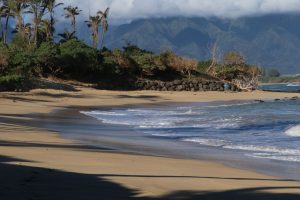 Sugar Cove is an idyllic location on the north shore of Maui, near Pā’ia. Hidden from view from the busy highway this pocket beach is home to a privately funded beach restoration effort that’s been ongoing for nearly three decades.
Sugar Cove is an idyllic location on the north shore of Maui, near Pā’ia. Hidden from view from the busy highway this pocket beach is home to a privately funded beach restoration effort that’s been ongoing for nearly three decades.
Adjacent to the beach are the Sugar Cove Condominiums, whose fourteen homeowners have funded millions of dollars of sand replenishment. Rich Salem is the President of the Sugar Cove Association of Apartment Owners (AOAO).
“The community originally wanted just to protect its watersports access. We subsequently realized how precious a resource the beach is, not only just for access, but as a community asset,” Salem explained. “For more than twenty-years we’ve brought in a total of 15,000 to 20,000-tons of sand to build the beach back up after erosion events and winter storms.”
The AOAO used to have a supply of sand on Maui but has recently had to ship in DLNR-approved sand from O‘ahu. Salem said, “We expect we can probably do another 10 years of sand feeding with our stockpile, hoping to build an equilibrium or stasis. It hinges on controlling wave energy on the west side of the pocket beach.”
The homeowners have been consulting with coastal specialists from Sea Engineering Inc., as well as experts from the DLNR Office of Coastal and Conservation Lands (OCCL), and the University of Hawai‘i Sea Grant Program.
On a recent visit to Sugar Cove Beach, a team of specialists walked from one end of the beach to the other, with a focus on options for the day when replenishment sand is no longer available.
Chris Conger of Sea Engineering remarked, “In the 1930’s-1960’s the beach was so wide, we have pictures of six-man canoes, people picnicking, and enjoying what was a wild healthy beach that you could pretty much walk all the way to Baldwin Beach. Chronic erosion began impacting this entire coastline more than fifty years ago.”
To diminish beach loss, and facing the prospect of no more sand, the homeowners and the experts are looking at potentially shoring up a natural rock groin on the west side. Facing the impacts of global climate change…sea level rise, more powerful storms, more erosion…and the prospect of losing the beach, Salem remarked, “I hope that perhaps over time the notion of beach replenishment and the value of restoring natural beaches across the islands will become more politically acceptable. We firmly believe that what we’re doing is maintaining and enhancing a public asset.”
The homeowners are continuing to work with their consultants and the DLNR to explore the science of integrating a natural looking groin to protect the beach and to also enhance beaches below, while they continue to explore sand sources. “We have a buffet of ideas and the situation here and at beaches everywhere need to be addressed in a multi-faceted way. We have an obligation to maintain such a spectacular spot that we were lucky enough to find when we first came here 25-30 years ago,” Salem added.



